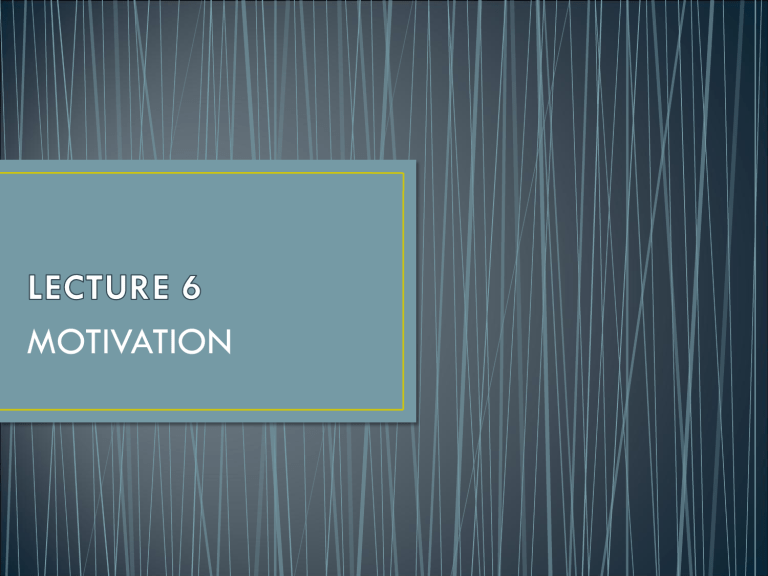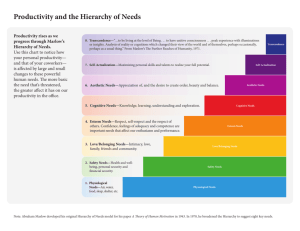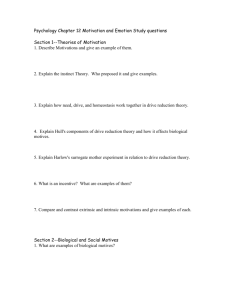lecture 6 - cda college

MOTIVATION
• Motivation is the processes that account for an individual’s intensity, direction, and persistence of effort toward attaining a goal.
Key Elements
Intensity: how hard a person tries
Direction: toward beneficial goal
Persistence: how long a person tries
• Primary motives also known as biological motives, have a definite physiological basis and are biologically necessary for survival of the individual or species (stimulation, senses like taste & smell, hunger, thirst).
(Gray Area between primary and secondary motives)
• The motives of competence, curiosity, manipulation, activity, and affection seem best to meet the criteria for this classification. An understanding of these general motives is important to the study of human behavior – especially in organizations. They are more relevant to organizational behavior than the primary motives.
They are unquestionably the most important to the study of organizational behavior.
Secondary motives are closely tied to the learning concepts.
They are acquired and learned through our interaction with people.
Psychological motives:
Related to self esteem, self security, self exhibition, self freedom and self assertion.
Examples are the need for approval, achievement, security, the motive of curiosity, competence, power, aggression, and self actualization.
Social motives:
Interact with others
Content Theories deal with “what” motivates people and it is concerned with individual needs and goals.
There is a hierarchy of five needs—physiological, safety, social, esteem, and self-actualization; as each need is substantially satisfied, the next need becomes dominant.
(Self-Actualization: The drive to become what one is capable of becoming)
Lower-Order Needs
Needs that are satisfied externally; physiological and safety needs.
Higher-Order Needs
Needs that are satisfied internally; social, esteem, and self-actualization needs.
Movement up the
Pyramid: Individuals cannot move to the next higher level until all needs at the current (lower) level are satisfied .
(physiological, safety, social, esteem and self-actualization)
What each need includes..
• Physiological: Hunger, thirst, shelter, and other bodily needs.
• Safety: Security and protection from physical and emotional harm.
• Social: Affection, belongingness, acceptance and friendship.
• Esteem: Internal factors such as self-respect, autonomy, and achievement, and external factors such as status, recognition, and attention.
• Self-actualization: Drive to become what one is capable of becoming includes growth, achieving one’s potential, and selffulfillment.
Existence
Relatedness
Growth
• Existence Needs: Similar to Maslow’s physiological and safety needs.
• Relatedness: Similar to Maslow’s social and status needs.
• Growth: Similar to Maslow’s esteem needs and self-actualization.
Theory X: The assumption that employees dislike work, are lazy, dislike responsibility, and must be coerced to perform. These employees have little ambition and need strict supervision.
Theory Y: The assumption that employees like work, are creative, seek responsibility, and can exercise self-direction. These employees work mostly alone without the need of supervision.
Two sets of factors resulting into satisfaction or dissatisfaction: motivators (achievement, recognition, advancement, the work itself, growth, responsibility) and hygiene (company policy and administration, supervision, relations with supervisor, relations with peers, relations with subordinates, salary, job security, personal life, work conditions, status).
Managers first need to make sure that hygiene factors are satisfied and then use motivators to increase motivation.
• A theory which states that achievement, power and affiliation are three important needs that help explain motivation.
• Need for Achievement (nAch): The drive to excel, to achieve in relationship to a set of standards, and to strive to succeed.
• Need for Power (nPow): The need to make others behave in a way in which they would not have behaved otherwise.
• Need for Affiliation (nAff): The desire for friendly and close interpersonal relationships.
Process Theories deal with the
“process” of motivation and is concerned with
“how” motivation occurs.
• A theory that says that says that the strength of a tendency to act in a certain way depends on the strength of an expectation that the act will be followed by a given outcome and on the attractiveness of that outcome to the individual.
• People will make better effort when they connect that with organizational rewards (for example bonuses, promotions etc).
• Between the individual effort and the individual performance there is the effort –performance relationship which is the probability perceived by the individual that exerting a given amount of effort will lead to performance.
• Between the individual performance and the organizational rewards there is the performance-reward relationship which is the degree to which the individual believes that performing at a particular level will lead to the attainment of a desired outcome.
• Between the organizational rewards and personal goals there is the rewards-personal goals relationship which is the degree to which organizational rewards satisfy an individual’s personal goals or needs and the attractiveness of those potential rewards for the individual.
• A theory that says that individuals compare their job inputs and outcomes with those of others and then respond to eliminate any inequities.
People evaluate the result of that comparison in order to form an impression of how they are treated by the organization. The equity theory suggests that people compare the ratio of input
(time, education, effort, experience etc) with output (pay, recognition, etc) to perform these equity processes.
Based on equity theory, when employees perceive inequity, they can be predicted to make one of six choices:
1.
Change their inputs (less effort)
2.
Change their outcomes (lower quality or quantity)
3.
Distort perceptions of self (I used to think I worked at a moderate pace, now I realize I work a lot harder than others)
4.
Distort perceptions of others (His job isn’t as desirable as I thought it was)
5.
Choose a different referent (I may not make as much as my sister I’m doing a lot better than my dad did at my age)
6.
Leave the field (quit job)
• A theory that says that specific and difficult goals, with feedback, lead to higher performance.
The more difficult the goal, the higher the level of performance.
• A theory that states that allocating extrinsic rewards
(such as pay for the effort) for behavior that had been previously intrinsically rewarding (due to pleasure associated) tends to decrease the overall level of motivation. This means someone that previously did the work for free, just for pleasure, now works full time and is getting paid for it.
• When your English teacher requires you to read a novel, you can attribute your course reading behavior to an external source. However, after the course is over, if you find yourself continuing reading a novel, it is an intrinsic reward.
• A theory that supports that an individual’s belief he/she is capable of performing a task, can make a better effort and will set higher personal goal for his/her performance.
• Based on Albert Bandura, the researcher who developed the theory, there are four ways by which self-efficacy can be increased:
• 1. Enactive mastery: Experience in the same task makes you more confident.
• 2. Vicarious Modeling: Becoming more confident because you see someone else doing the task.
• 3. Verbal Persuasion: Becoming more confident because someone convinces you that you have the skills required.
• 4. Arousal: Arousal leads to an energized state, which drives a person to complete a task.





